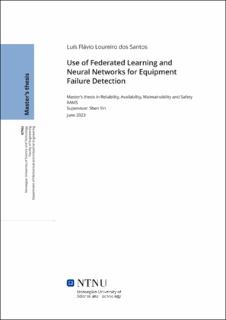| dc.description.abstract | This thesis aims to study and test the federated learning approach to predict the remaining useful
life of operating machines. Federated learning is a method associated with a machine learning
process to distribute the training across diferent devices and over time. The first application
of federated learning was the “next word prediction” feature of mobile phones’ keyboards. This
methodwas used to trainwith user’s typing data at the local device, butwithout sharing the original
information, keeping them private. All users benefit from the prediction, without sharing
any personal text.
Machine learning processes like artificial neural networks need significant historical data.
Remaining useful life prediction usually demands sensors’ data over time and information when
failures occur. Once the method is adequately trained, the system should be able to estimate
when the failure mode is developing and when the failure is likely to happen.
Federated Learning stands out from traditional machine learning methods by enabling the
training of machine learning models on multiple clients while keeping the original data private.
The results are then aggregated on a central server, without data sharing. One motivation
for companies to ensure data privacy is the General Data Protection Regulation (https:
//ec.europa.eu/info/law/law-topic/data-protection_en), while limited or intermittent
network access of certain assets, such as ships traveling around the globe, further supports the
case for this approach.
The data available for model training is crucial for achieving accurate predictions. For instance,
in the case of predicting the remaining useful life of machinery, a group of companies
owning similar equipment could utilize data from each other without sharing the original data.
All companies could benefit from more precise predictions by sharing only the training parameters
To test the performance of the proposed Federated Learning approach, publicly available
data from turbines will be utilized. The goal is to evaluate the model’s accuracy and how different
training configurations can affect the predictions. The method could then be expanded to
train on real data across different operators of similar equipment. | |
